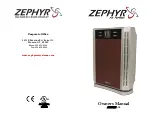
Page 10
FIGURE 12
24 VOLT FIELD WIRING WITH ELECTRONIC AND
ELECTRO-MECHANICAL THERMOSTATS
NOT ALL TERMINALS
ARE FOUND ON ALL
THERMOSTATS
Note - On electro-mechanical thermo
stats set anticipator at 0.1 amps.
Jumper terminals R and
OC when thermostat has
no night setback terminals
on units equipped with an
economizer.
A2 THERMOSTAT
TB1
IMPORTANT-Terminal connections at the wall plate or
subbase must be made securely. Loose control wire
connections may allow unit to operate but not with proper
response to room demand.
Unit Power-Up
A-General
1- Make sure that unit is installed in accordance with the
installation instructions and applicable codes.
2- Inspect all electrical wiring, both field‐ and
factory‐installed, for loose connections. Tighten as
required.
3- Check to ensure that refrigerant lines do not rub
against the cabinet or against other refrigerant lines.
4- Check voltage at main unit power connection.
Voltage must be within range listed on nameplate. If
not, consult power company and have voltage
condition corrected before starting unit.
5- Make sure filters are in place before start‐up.
6- Make sure there is no heating, cooling, or blower
demand from thermostat. Apply power to unit.
Blower Operation and Adjustments
A-Three Scroll Compressor Voltage Phasing
Three phase scroll compressors must be phased
sequentially to ensure correct compressor and blower
rotation and operation. Compressor and blower are
wired in phase at the factory. Power wires are
color-coded as follows: line 1-red, line 2-yellow, line
3-blue.
1- Observe suction and discharge pressures and
blower rotation on unit start-up.
If pressure differential is not observed or blower rotation is
not correct:
2- Suction pressure must drop, discharge pressure
must rise, and blower rotation must match rotation
marking.
3- Disconnect all remote electrical power supplies.
4- Reverse any two field-installed wires connected to
the line side of K3, TB2 or F4. Do not reverse wires
at blower contactor or compressors.
5- Make sure the connections are tight.
Discharge and suction pressures should operate at
their normal start‐up ranges.
Supply Air Inverter Units
- Units are equipped with a
phase monitor located in the control compartment. The
phase monitor will detect the phasing of incoming
power. If the incoming power is out of phase or if any of
the three phases are lost, the indicating LED on the
phase monitor will turn red and the unit will not start. In
normal operation with correct incoming power phasing,
the LED will be green.
B-Blower Operation
Initiate blower demand at thermostat according to
instructions provided with thermostat. Unit will cycle on
thermostat demand. The following steps apply to
applications using a typical electro-mechanical
thermostat.
1- Blower operation is manually set at the thermostat
subbase fan switch. With fan switch in
ON
position,
blowers will operate continuously.
2- With fan switch in
AUTO
position, the blowers will
cycle with demand. Blowers and entire unit will be off
when system switch is in
OFF
position.
C-Blower Access
The blower assembly is secured to a sliding frame which
allows the blower motor to be pulled out of the unit. See
figure 13.
1- Loosen the reusable wire tie which secures the
blower wiring to the blower motor mounting plate.
2- Remove and retain screws on either side of sliding
frame. Pull frame toward outside of unit.
3- Slide frame back into original position when finished
servicing. Reattach the blower wiring in the previous
location on the blower motor base using the wire tie.
4- Replace retained screws on either side of the sliding
frame.











































